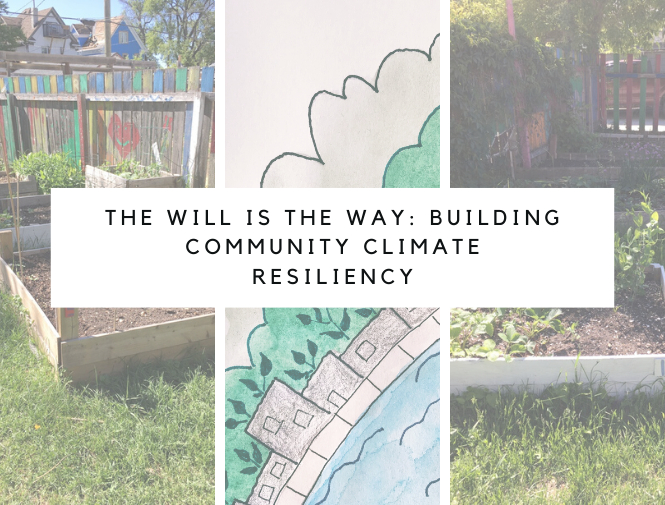
Building Community Climate Resiliency
April 29, 2020
Overview
Phase 1 of this project was undertaken with the support of the Province of Manitoba, the City of Winnipeg, Eco-Canada, the RBC Foundation, and the Winnipeg Foundation. The goal of Phase 1 was to identify gaps in community climate resiliency knowledge and work in Winnipeg. Over 90 organizations were invited to participate in a series of surveys and an informative webinar. A comprehensive analysis of the information collected is compiled in The Will is the Way: Building Community Climate Resiliency, published in August 2020. We are currently planning for Phase 2 of this project in which we hope to partner with community-based organizations to undertake neighbourhood level resiliency planning in Winnipeg’s inner-city areas.
Why is this important in Manitoba?
The results of the surveys we conducted reveal that while there are clear and consistent ideas about what needs to be done to address climate resiliency, there is low clarity and satisfaction with how it is being done. In particular, the inclusion of Indigenous perspectives is perceived as being well behind what it should be. Furthermore, survey results point to specific barriers that constrain the day-to-day work of climate resiliency. From the point of view of the respondents, the most significant barriers to climate change resiliency in Winnipeg are inadequate municipal funding and political support.
Speakers
Jeff Zukiwsky is the director of climate and community resilience at the All One Sky Foundation, and organization based out of Alberta and British Columbia which provides guidance on climate resilience, energy poverty, and economic impacts of climate change. Jeff explained that climate change adaptation consists of both climate change mitigation and climate change resilience. He explained how climate risk is determined by assessing hazards, exposure, and vulnerability, and shared examples of approaches to climate resilience planning and best practice examples from other Canadian cities.
Duane Nicol, Chief Administrative Officer for the City of Selkirk, shared highlights from Selkirk’s climate resiliency planning process. Selkirk’s 2019 Climate Change Adaptation Strategy is intended to provide a corporate target to reduce greenhouse gas (GHG) emissions and to improve municipal operations and management to be more efficient and more resilient. The City also participated in the Federation of Canadian Municipalities’ (FCM) Climate Management Network in 2018, and was the only municipality from Manitoba to be selected.
Lindsay Mierau, from the City of Winnipeg’s Office of Sustainability, discussed Winnipeg’s climate resiliency planning efforts dating back to 1998, when the City joined the FCM Partners for Climate Action. In 2018, City Council approved the Winnipeg Climate Action Plan, which includes a GHG Inventory, which identifies the top three GHG sources as transportation, building heating from natural gas, and waste disposal. The Plan sets time-based goals for emission reductions and seven areas of climate plan implementation, including resiliency and adaptation.
Martha Barwinsky, from the City of Winnipeg’s Urban Forestry Department, explained that trees offset climate change by mitigating heat, absorbing emissions, and improving community health. Unfortunately Winnipeg’s mature elm and ash canopy is at threatened by disease and pest infestation. Winnipeg is responding to the threats to its trees by doing a tree inventory, managing pests, pruning programs, and tree protection and preservation. Winnipeg has also developed a project called the One Million Trees Challenge with the objective of planting one million new trees before the city population reaches one million.
Michelle Paetkau, from the City of Winnipeg’s Water and Waste Department, explained that new plans to address the hazards of combined sewer overflows include increased reliance on green infrastructure to absorb and slow the flow of stormwater. The City has also begun experimenting with using sewage to create a biosolid fertilizer, which is valuable to farmers, redirects it from the landfill, sequesters carbon, and helps soil to hold more water. The City also intends to use biosolids to create soil to protect the clay cap over city landfills, allowing native plant species to be grown on the top of the cap and protect sealed landfills.
Three additional City of Winnipeg staff members: Rod Penner (City Naturalist), Kendall Thiessen (Riverbank Management Engineer), and Dave Domke (Manager of Parks and Open Spaces), were available to answer questions during the Q&A portion of the event.
Emily Halldorson, Manitoba Eco-Network Resource Manager, moderated the event, with support from The Will is the Way report author Allie Caporale and Manitoba Eco-Network Executive Director Glen Koroluk.
Key Questions
Has the City of Winnipeg ever analyzed the tree canopy across the city by income level in different neighbourhoods? Are low-income neighbourhoods well-covered?
Although the City has not done this kind of analysis yet, staff know that the canopy cover is the most mature in the city core where many lower income people live. A deeper comparison of canopy cover in relation to income level will be conducted using the I-Tree data which has been gathered as part of the development of the City of Winnipeg’s Urban Forest Strategy.
Lake Winnipeg is an incredible climate resiliency resource to Manitoba. Winnipeg’s North End Sewage Treatment Plant is the largest point source emitter of phosphorous into Lake Winnipeg. What is the City of Winnipeg’s current plan to address the health of Lake Winnipeg as soon as possible?
The City is in the midst of a 2008 plan to upgrade all three local water treatment facilities to remove phosphorus, starting with the smallest plant. The medium-sized plant is currently being upgraded, set for completion in 2022. The largest plant in the North End has also begun Phase 1 of its upgrade process, which will cost a total of $1.8 billion. Water and Waste also has representation on advisory committees with the International Institute for Sustainable Development and the Province of Manitoba to continue developing plans for water treatment upgrades.
Does the City of Winnipeg have any plans to subsidize low-income homeowners wanting to make their homes more climate resilient?
The City of Winnipeg and several climate resilience groups have secured grant funding for energy poverty alleviation from the Federation of Canadian Municipalities. The City has been working with local non-profits to gather data on the geographic distribution of energy poverty across Winnipeg neighbourhoods. There may also be a small levy applied to energy bills to cover upgrade costs.
How can cash-strapped municipalities access funds to implement climate resiliency initiatives?
In the City of Selkirk, projects that have been implemented have not required new funding, but instead have reallocated the usual funding to a better purpose. The City of Selkirk has developed a system to track lifecycle costs of projects, which enables clearer communication with the public on the value of a seemingly expensive project. The key is to always consider climate change with every capital project, which means imagining the full lifespan of a project. Requests for Proposals for contractors must always include this forward thinking. To not do so would be negligent to future generations.

